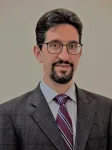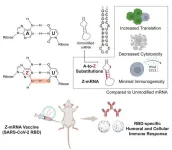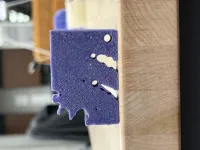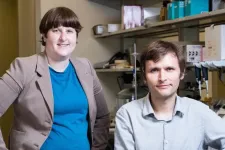(Press-News.org) A multi-institutional project led by a Penn State researcher is focused on developing an all-in-one semiconductor device that can both store data and perform computations. The project recently received $2 million in funding over three years as part of the new National Science Foundation Future of Semiconductors (FuSe) program, a $45.6 million investment to advance semiconductor technologies and manufacturing through 24 research and education projects across the United States.
“The goal of the program is to support innovation in semiconductors, which we need to address rapidly approaching limitations of current technology,” said principal investigator Saptarshi Das, associate professor of engineering science and mechanics in Penn State’s College of Engineering.
Microchip technology, crucial for computing and data storage in a wide range of advanced devices from smartphones to electric vehicles, has historically advanced to accommodate a doubling of transistor capacity approximately every two years. This phenomenon is known as Moore's Law. However, Moore's Law reached a standstill almost a decade ago, constrained by what Das called the inherent limitations of the prevailing materials and techniques.
According to Das, stagnation in Moore’s Law only accounts for making the transistors smaller.
“Another major problem in the semiconductor architecture is you have to get data from the memory, make the computation and put the data back,” Das said. “This shuttling consumes a lot of power. Can we do it in the same device?”
Das teamed up with co-principal investigators Ritesh Agarwal, professor of materials engineering, and Deep Jariwala, associate professor of electrical systems engineering, both at the University of Pennsylvania. Agarwal and Jariwala had developed new semiconducting materials comprising various phases of indium selenide that Das said they thought might be able to bridge the gap between storage and computation in a single device.
To help address how transistors based on these novel materials might fit into the existing confines of technology, they brought in Priyadarshini Panda, assistant professor of electrical engineering at Yale University, who specializes in artificial intelligence and its application across full systems — in other words, if the team develops a singular, multifunction semiconductor device, how will it operate at the system level with other such devices?
“It’s not just the material or just the device — every piece has to come together for the project to be successful,” said Das, who is an expert in neuromorphic computing, or engineering computational elements that model the human brain. “We could make a champion device but if it doesn’t fit in a system, it doesn’t work. That is why we need this full team, with complementary expertise.”
The semiconducting material developed by the University of Pennsylvania team is ferroelectric, meaning it holds an electric charge that can be flipped if a voltage is applied. It’s unusual for a material to be both ferroelectric and semiconducting, Das said.
“Ferroelectric materials are dipoles, pointing up or down, that can be changed by applying a voltage — it’s a natural storage device with two stages,” Das said, explaining that it is comparable to binary code, the ones and zeroes that serve as the underlying architecture for modern computing. “Ferroelectric materials typically can’t be gated — or partially turned off — like semiconductors, when you stop the material’s conductance to control information or energy flow. But this ferroelectric material is a semiconductor, so it can be gated.”
The researchers said they plan to use this material to develop a new two-in-one storage and computing device that can integrate with standard silicon chips at the back end. This would help with quicker implementation, since the new devices could work with existing systems, according to Das. That would also set the stage for developing and manufacturing more neuromorphic computing devices, which mimic the energy saving and unique storage abilities of the human brain.
“This material will let us capture the best of both worlds: storage and computation,” Das said. “That opens up the possibilities, and that’s why we’re so excited about this project.”
The funding will also support four students, one per collaborator, to work on this project.
"Our investment will help train the next generation of talent necessary to fill key openings in the semiconductor industry and grow our economy from the middle out and bottom up," said NSF Director Sethuraman Panchanathan in a statement. "By supporting novel, transdisciplinary research, we will enable breakthroughs in semiconductors and microelectronics and address the national need for a reliable, secure supply of innovative semiconductor technologies, systems and professionals."
Das is also affiliated with the Material Research Institute and the Center for Neural Engineering and holds courtesy appointments in materials science and engineering and in electrical engineering and computer science.
END
Project aims to develop all-in-one semiconductor that stores, processes data
2023-10-03
ELSE PRESS RELEASES FROM THIS DATE:
Nemours Children’s Health hosts first-ever pediatric session at HLTH
2023-10-03
Nemours Children’s Health will host the first-ever dedicated pediatric session at HLTH, the leading platform bringing together the entire health ecosystem focused on health innovation and transformation. This invited program, “Elevating Kids Health Well Beyond Medicine,” will extend HLTH’s 2023 theme, “Elevating Humanity,” to focus on health in childhood and why it is the only way to build good health across the lifespan.
“The child health perspective is an essential viewpoint for the attendees of HLTH to consider and we are proud to offer ...
OU Engineering among top 28 teams nationwide selected for DEPSCoR Grant
2023-10-03
University of Oklahoma engineering researcher Reza Foudazi, Ph.D., has been selected to receive a $600,000 grant from the U.S. Department of Defense under the Defense Established Program to Stimulate Competitive Research, or DEPSCoR. The highly competitive grant was awarded to only 28 academic teams nationwide.
An associate professor in the School of Sustainable Chemical, Biological and Materials Engineering, Foudazi’s research centers on the exploration of electrochemical energy storage systems that incorporate multivalent ions. ...
From A to Z: An alternative base modification for mRNA therapeutics
2023-10-03
Messenger RNA (mRNA) technology has become popular in the last few years due to its use in COVID-19 vaccines. This technology has been so groundbreaking that it recently won the 2023 Nobel Prize in medicine “for discoveries concerning nucleoside base modifications that enabled the development of effective mRNA vaccines against COVID-19.” This isn’t new technology, however— modified mRNAs have been studied for decades and show significant potential for therapeutic applications. Compared to unmodified mRNAs, modified ...
Legendary UTA professor establishes endowed professorship in heat transfer
2023-10-03
Abdolhossein Haji-Sheikh, a retired professor in the Mechanical and Aerospace Engineering Department at The University of Texas at Arlington, has made a $500,000 gift to support his former department.
The gift creates an endowed professorship in heat transfer, one of Haji-Sheikh’s areas of expertise during his decades of teaching at UTA. The professorship will be awarded in 2026.
Haji-Sheikh began his career at what was then Arlington State College in 1966. He said he wants to give back to ...
Instant evolution: AI designs new robot from scratch in seconds
2023-10-03
Inventor of xenobots unveils new advance toward artificial life
New AI algorithm compresses billions of years of evolution into seconds
The evolved robot has three legs and rear fins, something a human engineer would never devise
Researcher: ‘Now anyone can watch evolution in action as AI generates better and better robot bodies in real time.’
A team led by Northwestern University researchers has developed the first artificial intelligence (AI) to date that can intelligently design robots from ...
Two Rice bioengineers win NIH Director’s New Innovator awards
2023-10-03
Two Rice University bioengineers received the National Institutes of Health (NIH) Director’s New Innovator Award (NIA) for creative research projects demonstrating broad impact potential.
Part of the High-Risk, High-Reward Research program, NIA awards support early-career investigators with ambitious, unconventional project proposals “in any area of biomedical, behavioral or social science research relevant to the NIH mission,” according to the agency’s website.
Rice’s ...
A promising treatment on the horizon for cancer-related fatigue
2023-10-03
Cancer-related fatigue (CRF) is a debilitating yet all-too-common condition, which can severely affect quality of life for patients undergoing treatment. For those struggling with CRF, there have been no effective pharmaceutical treatments for the constellation of symptoms that together define the syndrome.
In a new study led by Yale Cancer Center researchers at Yale School of Medicine, the team found that a metabolism-targeting drug called dichloroacetate (DCA) helped alleviate CRF in mice, without interfering with cancer ...
NRG Oncology-RTOG 1308 accrual completion: First phase III NCTN clinical trial comparing photon versus proton therapy to meet accrual target
2023-10-03
Effective September 26, 2023, NRG Oncology-RTOG 1308, a phase III randomized trial comparing overall survival after photon versus proton chemoradiotherapy for patients with inoperable stage II-IIIB non-small cell lung cancer (NSCLC) has met its accrual target. The trial, one of several NRG Oncology ongoing clinical trials across various malignancies within the National Clinical Trials Network (NCTN) that compare photon versus proton radiation therapy techniques, is the first phase III head-to-head comparison of these ...
Carbon capture method plucks CO2 straight from the air
2023-10-03
Even as the world slowly begins to decarbonize industrial processes, achieving lower concentrations of atmospheric carbon requires technologies that remove existing carbon dioxide from the atmosphere — rather than just prevent the creation of it.
Typical carbon capture catches CO2 directly from the source of a carbon-intensive process. Ambient carbon capture, or “direct air capture” (DAC) on the other hand, can take carbon out of typical environmental conditions and serves as one weapon in the battle against climate change, particularly as reliance ...
Dr. Tanya Stoyanova receives Department of Defense award to find new lung cancer treatments
2023-10-03
Dr. Tanya Stoyanova, associate professor of molecular and medical pharmacology and urology at the David Geffen School of Medicine at UCLA, was awarded a $350,000 Idea Development Award from the Department of Defense.
The award will help Stoyanova, a member of the UCLA Jonsson Comprehensive Cancer Center, to identify new cancer detection and treatment strategies for small cell lung cancer, a highly aggressive form of the disease that accounts for approximately 15% of lung cancers. Known for spreading quickly, most people diagnosed with the disease face low chances of survival beyond five years.
The award ...





